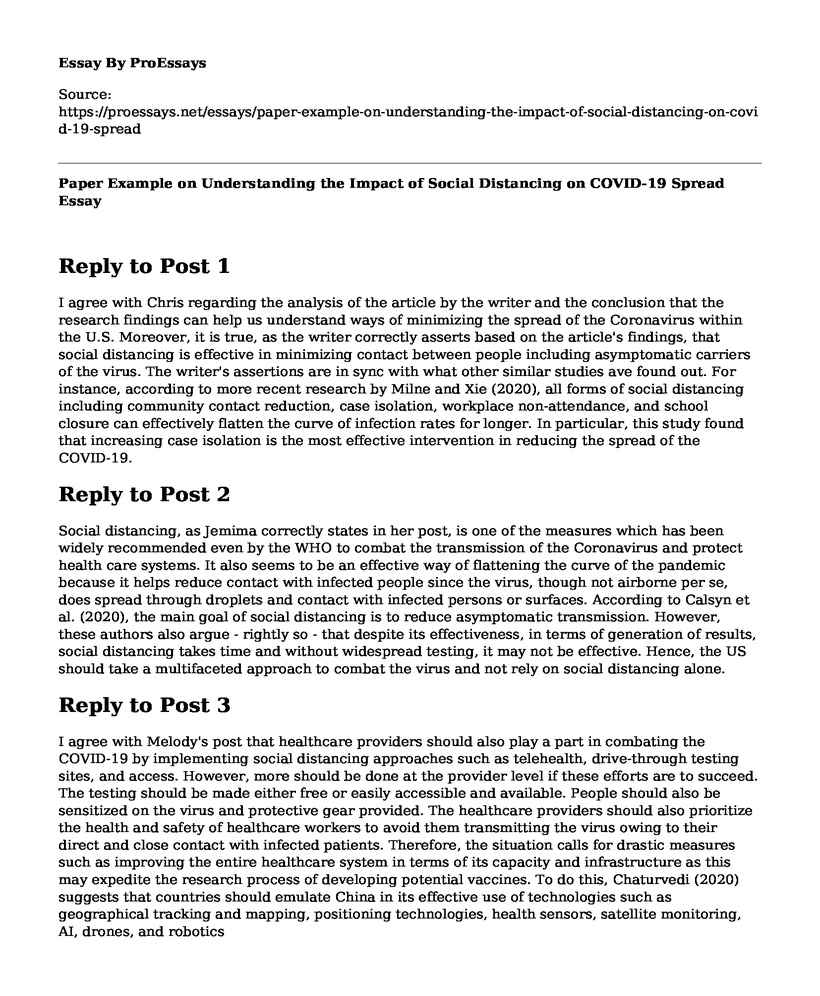Reply to Post 1
I agree with Chris regarding the analysis of the article by the writer and the conclusion that the research findings can help us understand ways of minimizing the spread of the Coronavirus within the U.S. Moreover, it is true, as the writer correctly asserts based on the article's findings, that social distancing is effective in minimizing contact between people including asymptomatic carriers of the virus. The writer's assertions are in sync with what other similar studies ave found out. For instance, according to more recent research by Milne and Xie (2020), all forms of social distancing including community contact reduction, case isolation, workplace non-attendance, and school closure can effectively flatten the curve of infection rates for longer. In particular, this study found that increasing case isolation is the most effective intervention in reducing the spread of the COVID-19.
Reply to Post 2
Social distancing, as Jemima correctly states in her post, is one of the measures which has been widely recommended even by the WHO to combat the transmission of the Coronavirus and protect health care systems. It also seems to be an effective way of flattening the curve of the pandemic because it helps reduce contact with infected people since the virus, though not airborne per se, does spread through droplets and contact with infected persons or surfaces. According to Calsyn et al. (2020), the main goal of social distancing is to reduce asymptomatic transmission. However, these authors also argue - rightly so - that despite its effectiveness, in terms of generation of results, social distancing takes time and without widespread testing, it may not be effective. Hence, the US should take a multifaceted approach to combat the virus and not rely on social distancing alone.
Reply to Post 3
I agree with Melody's post that healthcare providers should also play a part in combating the COVID-19 by implementing social distancing approaches such as telehealth, drive-through testing sites, and access. However, more should be done at the provider level if these efforts are to succeed. The testing should be made either free or easily accessible and available. People should also be sensitized on the virus and protective gear provided. The healthcare providers should also prioritize the health and safety of healthcare workers to avoid them transmitting the virus owing to their direct and close contact with infected patients. Therefore, the situation calls for drastic measures such as improving the entire healthcare system in terms of its capacity and infrastructure as this may expedite the research process of developing potential vaccines. To do this, Chaturvedi (2020) suggests that countries should emulate China in its effective use of technologies such as geographical tracking and mapping, positioning technologies, health sensors, satellite monitoring, AI, drones, and robotics
Reply to Post 4
It is true, as Gibann observes, that the reason South Korea has been more successful than most Western nations in flattening the epidemic curve of the COVID-19 spread majorly through widespread mass testing, early lockdown, and quarantine. However, I think there is more to South Korea's success story that the US can learn for now and the future. South Korea's ability to control the spread of the coronavirus may be attributed mainly to the nation's near-universal healthcare system, government transparency, and swift action, and contact tracing and testing as succinctly observed by Shorrock (2020). In the US, when reports of the COVID-19 first emerged, public health officials did not take it seriously by initiating mass testing, lockdown, and contact tracing as South Korea did. When the virus broke out, the US President stated that it would just pass away and that there was no need to worry. The U.S. failed to take the pandemic seriously from the beginning hence the lesson it should learn is to put in place adequate measures in the future as South Korea did. However, these other countries including the US are currently on the right track in combating the pandemic.
References
Calsyn, M., Gee, E., Waldrop, T., & Rapfogel, N. (2020). Social distancing to fight coronavirus: A strategy that is working must continue. Center for American Progress. https://www.americanprogress.org/issues/healthcare/news/2020/03/25/482278/social-distancing-fight-coronavirus-strategy-working-must-continue/
Chaturvedi, A. (2020). The China way: Use of technology to combat Corvid-19. GeospatialWorld. https://www.geospatialworld.net/article/the-sino-approach-use-of-technology-to-combat-COVID-19/
Milne, G. J., & Xie, S. (2020). The effectiveness of social distancing in mitigation COVID-19 spread: A modeling analysis. MedRxiv. https://www.medrxiv.org/content/10.1101/2020.03.20.20040055v1
Shorrock, T. (2020). How South Korea triumphed, and the US floundered, over the pandemic. The Nation, https://www.thenation.com/article/world/coronavirus-south-korea-america/
Cite this page
Paper Example on Understanding the Impact of Social Distancing on COVID-19 Spread. (2023, May 21). Retrieved from https://proessays.net/essays/paper-example-on-understanding-the-impact-of-social-distancing-on-covid-19-spread
If you are the original author of this essay and no longer wish to have it published on the ProEssays website, please click below to request its removal:
- Literature Review Example on Teens' Awareness of Periodontitis and Oral Health
- Leveraging the Marketing Mix to Create Value in Luxury Hospitality
- Researched Paper on Strategies for Students with Disabilities
- Research Paper on Immunization: Key to Combatting Life-Threatening Diseases
- Essay Example on Testicular Pain: Causes & Symptoms
- Essay Example on Asthma Management in Children: Home & Medical Collaboration
- My Big Brother's Cancer Diagnosis: A Life-Changing Moment - Paper Example







